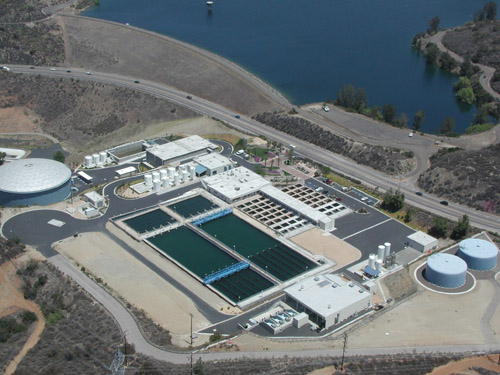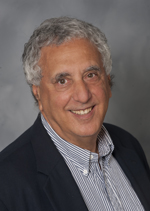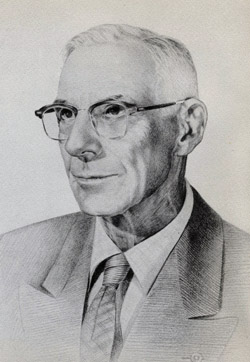
-55th in a Series-
Exit 23, Lake Jennings Park Road, Lakeside, California ~ R.M. Levy Water Treatment Plant
By Donald H. Harrison


LAKESIDE, California — I have a saying that “there’s a Jewish story everywhere” but who would have thought that it would take a former governor of Illinois to put me on the search for one right in my own back yard in San Diego County, California.
Back in 2005, I was reading Thirst for Independence: The San Diego Water Story by Dan Walker, who had grown up in the Encanto neighborhood of San Diego before moving to Illinois where a career in the law and politics led to his serving as that state’s governor.
After leaving office, Walker became a principal in a savings and loan association, and engaged in what the federal government contended were illegal loan practices. After pleading guilty, Walker spent 18 months of a 7-year-sentence at a minimum- security prison in Duluth, Minn. He decided to rebuild his life in his boyhood San Diego County, where he has been redeeming his reputation by writing solid books of local interest.
I met Walker at a party for authors thrown by our mutual publisher, Sunbelt Publications of El Cajon. We exchanged books—I being quite pleased that Walker was interested in reading my Louis Rose: San Diego’s First Jewish Settler. Reading Walker’s book resulted in my learning about the various dams on San Diego County rivers, our county’s dependence on imported water from the Colorado and Feather Rivers, and—not surprisingly, given the background of the author—some of the behind-the-scenes forces governing the politics of water.
On page 88, I was startled to read that in the Helix Water District—which old timers know as the former La Mesa, Lemon Grove and Spring Valley Irrigation District— “all water goes through the district’s $50 million state-of-the-art R.M. Levy Treatment Plant at Lakeside that uses the advanced ozonation process to improve taste and color.” The treatment plant is adjacent to Lake Jennings.
“All state and federal standards for quality and safety are met and the plant’s capacity is 106 million gallons per day,” Walker wrote. “The San Diego Chapter of the American Institute of Architects recently granted its coveted Orchid Award to the plant as an outstanding Environmental Solutions Project. The plant is hailed not just for its physical appearance but also for being the first in San Diego County to provide such clean, fresh-tasting, ozone-treated water that there is, as the boosters say, ‘no need to lug jugs of bottled water home anymore.'”
I had thought that I knew of all the Jews for whom public buildings in San Diego County had been named. “Levy, who was Levy?” I wondered.
Kate Breece, public relations director at the Helix Water District, told me R.M. “Rube” Levy had been a longtime director of the district, a man who had led a colorful life before he died in a 1959 traffic accident during a hunting trip in Imperial County. At one time, he had played professional baseball, she understood.
Breece directed me to Bob Friedgen, a former general manager of the Helix Water District, who added that Levy’s father, Henry, had owned Levy’s Hardware Store in La Mesa. Friedgen said he thought, but could not be certain, that the Levys were members of the Jewish community; that prior to World War I, Levy had played second base perhaps in the Detroit Tigers organization, and that Levy had won medals for his World War I military exploits in Europe.
Friedgen, in turn, referred me to Norrie West, a retired journalist and sports publicist, who recalled that as a 17-year-old in 1933 he bought his first baseball glove at Levy Hardware, located on what then was called Lookout Avenue, and today is known as La Mesa Boulevard. He also remembered that a principal of Grossmont High School, Carl Quicksall, had been gravely injured in the accident in which Levy had died. He recalled that Levy, then 70, apparently fell asleep at the wheel.
Paul Engstrand, a retired principal of the law firm of Jennings Engstrand and Henrikson, which represented the Helix Water District, remembered that Levy was a strong water board chairman, who when running a meeting, “kept on top of things.” Levy at one point became an advocate for putting a traffic signal on La Mesa Boulevard—and when he heard that a decision would be based upon traffic counts—“drove back and forth over that route all afternoon to get the count up,” Engstrand remembered.
I also called George Bailey, the former mayor of La Mesa who later became a member of the county Board of Supervisors, but Bailey, alas, couldn’t recall much more about Levy. Bailey’s mayoral successor, Art Madrid, only knew him by name, and some longtime members of Tifereth Israel Synagogue, the San Diego congregation closest to La Mesa, also couldn’t remember Levy. As a point of interest, however, I did learn that the La Mesa neighborhood in which Levy had resided had been named “Mount Nebo” by the developers—making me wonder if they considered the area between their mount and the Pacific Ocean to be the western “Promised Land.”
Via phone and email, I put out queries about R.M. “Rube” Levy to baseball and military historians, to the Jewish Historical Society of San Diego, the San Diego Jewish Genealogical Society, Jewish War Veterans and to various longtime residents.
While I waited for a break—something that would definitively tie Levy to San Diego’s Jewish community, other than his surname—I learned from a CD thoughtfully sent to me by Breece what makes the R.M. Levy Water Treatment Plant near Lake Jennings so special. Built about four years after Levy’s death, it more recently underwent modernization. The “ozonation” process that Governor Walker mentioned involves passing electricity through oxygen to create ozone and then injecting that gas into the water supply. Highly reactive, the ozone bonds with various organisms that might be in the water, forming solids that can be filtered out of the water. Ozonation is followed by chlorination.
Roberta Berman of the San Diego Jewish Genealogical Society subsequently messaged me that a Reuben Martin Levy, whose birth and death dates matched those of the man I was seeking, was buried in plot S 1268 at Fort Rosecrans National Cemetery, and that after serving as a 2nd lieutenant in the infantry, he had been demobilized at Camp Kearny, California.
Other genealogical records found by Berman indicated that Levy’s mother’s maiden name was Wingate. Given that Wingate is not usually a Jewish name (but then again, neither is my surname “Harrison”), I wondered whether Levy perhaps had been the child or descendant of an inter-marriage, who was raised outside the Jewish religion. This might account for why he was so unknown in the Jewish community.
A phone call to Fort Rosecrans National Cemetery substantiated this hypothesis. Delia Fernandez, noting that Levy’s gravesite was not far from her office at the cemetery, took a quick walk outside to look it over. According to the markings on the stone, Levy had won the Distinguished Service Cross and the Silver Star during his World War I service. The religious icon on his stone was a Christian cross.
So after all that, I had to wonder had I really been embarked on a “Jewish” story? Yes, I decided, but the story in question wasn’t Levy’s. Instead, it was a story about the interesting byways one can travel in the process of Jewish historical research.
*
From Lake Jennings Park Road, Exit 23, turn left and the plant at 9550 Lake Jennings Park Road will be on the left.
Harrison is editor of San Diego Jewish World. You may comment to him at donald.harrison@sdjewishworld.com. This story originally appeared in 2005 on jewishsightseeing.com